Abstract
Background
Although NDRG2 is a candidate tumor suppressor, its exact role in renal cell carcinoma (RCC) is not fully understood. We investigated the functional role of NDRG2 and its clinical relevance in RCC tumorigenesis.
Methods
NDRG2 expression and its clinical implications in clear cell RCC were evaluated. Biological function was assessed by a proliferation assay, anchorage-independent growth assay, and wound healing and transwell migration assays in RCC cell lines overexpressing NDRG2 coupled with an investigation of the effects of NDRG2 expression on the epithelial–mesenchymal transition (EMT).
Results
NDRG2 was differentially expressed in patients with RCC. A loss of NDRG2 was significantly associated with a higher proportion of tumors >10 cm and a high nuclear grade. Furthermore, multivariate analyses indicated that a loss of NDRG2 was an independent poor prognostic factor for patient survival (recurrence-free survival, hazard ratio 7.901; disease-specific survival, hazard ratio 15.395; overall survival, hazard ratio 11.339; P < 0.001 for all parameters). NDRG2 expression inhibited the anchorage-independent growth and migration of RCC cells. NDRG2 expression also modulated the expression of EMT-related genes such as Snail, Slug, and SIP1, and it decreased EMT signaling in RCC cells. Finally, NDRG2 recovered E-cadherin expression in E-cadherin-negative RCC cells.
Conclusions
These results indicate that a lack of NDRG2 is associated with oncogenic properties through the loss of its role as a tumor suppressor, and that NDRG2 is an independent poor prognostic factor predicting survival in clear cell RCC, suggesting that it can serve as a novel prognostic biomarker.




Similar content being viewed by others
References
Parkin DM, Bray F, Ferlay J, Pisani P. Global cancer statistics, 2002. CA Cancer J Clin. 2005;55:74–108.
Zisman A, Pantuck AJ, Wieder J, et al. Risk group assessment and clinical outcome algorithm to predict the natural history of patients with surgically resected renal cell carcinoma. J Clin Oncol. 2002;20:4559–66.
Motzer RJ, Hutson TE, Tomczak P, et al. Overall survival and updated results for sunitinib compared with interferon alfa in patients with metastatic renal cell carcinoma. J Clin Oncol. 2009;27:3584–90.
Zisman A, Pantuck AJ, Dorey F, et al. Improved prognostication of renal cell carcinoma using an integrated staging system. J Clin Oncol. 2001;19:1649–57.
Patard JJ, Kim HL, Lam JS, et al. Use of the University of California Los Angeles integrated staging system to predict survival in renal cell carcinoma: an international multicenter study. J Clin Oncol. 2004;22:3316–22.
Frank I, Blute ML, Cheville JC, Lohse CM, Weaver AL, Zincke H. An outcome prediction model for patients with clear cell renal cell carcinoma treated with radical nephrectomy based on tumor stage, size, grade and necrosis: the SSIGN score. J Urol. 2002;168:2395–400.
Klatte T, Seligson DB, Leppert JT, et al. The chemokine receptor CXCR3 is an independent prognostic factor in patients with localized clear cell renal cell carcinoma. J Urol. 2008;179:61–6.
Lam JS, Klatte T, Kim HL, et al. Prognostic factors and selection for clinical studies of patients with kidney cancer. Crit Rev Oncol Hematol. 2008;65:235–62.
Zhou RH, Kokame K, Tsukamoto Y, Yutani C, Kato H, Miyata T. Characterization of the human NDRG gene family: a newly identified member, NDRG4, is specifically expressed in brain and heart. Genomics. 2001;73:86–97.
Qu X, Zhai Y, Wei H, et al. Characterization and expression of three novel differentiation-related genes belong to the human NDRG gene family. Mol Cell Biochem. 2002;229:35–44.
Liu N, Wang L, Li X, et al. N-Myc downstream-regulated gene 2 is involved in p53-mediated apoptosis. Nucleic Acids Res. 2008;36:5335–49.
Ma J, Jin H, Wang H, et al. Expression of NDRG2 in clear cell renal cell carcinoma. Biol Pharm Bull. 2008;31:1316–20.
Lusis EA, Watson MA, Chicoine MR, et al. Integrative genomic analysis identifies NDRG2 as a candidate tumor suppressor gene frequently inactivated in clinically aggressive meningioma. Cancer Res. 2005;65:7121–6.
Phillips HS, Kharbanda S, Chen R, et al. Molecular subclasses of high-grade glioma predict prognosis, delineate a pattern of disease progression, and resemble stages in neurogenesis. Cancer Cell. 2006;9:157–73.
Ma JJ, Liao CG, Jiang X, Zhao HD, Yao LB, Bao TY. NDRG2 suppresses the proliferation of clear cell renal cell carcinoma cell A-498. J Exp Clin Cancer Res. 2010;29:103–9.
Choi SC, Kim KD, Kim JT, et al. Expression of human NDRG2 by myeloid dendritic cells inhibits down-regulation of activated leukocyte cell adhesion molecule (ALCAM) and contributes to maintenance of T cell stimulatory activity. J Leukoc Biol. 2008;83:89–98.
Kim YJ, Yoon SY, Kim JT, et al. NDRG2 expression decreases with tumor stages and regulates TCF/beta-catenin signaling in human colon carcinoma. Carcinogenesis. 2009;30:598–605.
Choi SC, Yoon SR, Park YP, et al. Expression of NDRG2 is related to tumor progression and survival of gastric cancer patients through Fas-mediated cell death. Exp Mol Med. 2007;39:705–14.
Shi H, Li N, Li S, et al. Expression of NDRG2 in esophageal squamous cell carcinoma. Cancer Sci. 2010;101:1292–9.
Mordalska A, Latek J, Ferenc T, et al. Evaluation of NDRG2 gene expression in primary papillary thyroid carcinoma and in metastases of this neoplasm to regional lymph nodes. Thyroid Res. 2010;3:6–13.
Furuta H, Kondo Y, Nakahata S, Hamasaki M, Sakoda S, Morishita K. NDRG2 is a candidate tumor-suppressor for oral squamous-cell carcinoma. Biochem Biophys Res Commun. 2010;391:1785–91.
Lorentzen A, Lewinsky RH, Bornholdt J, Vogel LK, Mitchelmore C. Expression profile of the N-myc downstream regulated gene 2 (NDRG2) in human cancers with focus on breast cancer. BMC Cancer. 2011;11:14–21.
Price JE. Clonogenicity and experimental metastatic potential of spontaneous mouse mammary neoplasms. J Natl Cancer Inst. 1986;77:529–35.
Peehl DM, Stanbridge EJ. Anchorage-independent growth of normal human fibroblasts. Proc Natl Acad Sci USA. 1981;78:3053–7.
Micalizzi DS, Farabaugh SM, Ford HL. Epithelial-mesenchymal transition in cancer: parallels between normal development and tumor progression. J Mammary Gland Biol Neoplasia. 2010;15:117–34.
Friedl P, Gilmour D. Collective cell migration in morphogenesis, regeneration and cancer. Nat Rev Mol Cell Biol. 2009;10:445–57.
Testa JR, Bellacosa A. AKT plays a central role in tumorigenesis. Proc Natl Acad Sci USA. 2001;98:10983–5.
Grille SJ, Bellacosa A, Upson J, et al. The protein kinase Akt induces epithelial mesenchymal transition and promotes enhanced motility and invasiveness of squamous cell carcinoma lines. Cancer Res. 2003;63:2172–8.
Bellacosa A, Testa JR, Moore R, Larue L. A portrait of AKT kinases: human cancer and animal models depict a family with strong individualities. Cancer Biol Ther. 2004;3:268–75.
Hollander MC, Blumenthal GM, Dennis PA. PTEN loss in the continuum of common cancers, rare syndromes and mouse models. Nat Rev Cancer. 2011;11:289–301.
Waite KA, Eng C. Protean PTEN: form and function. Am J Hum Genet. 2002;70:829–44.
Takahashi-Yanaga F, Kahn M. Targeting Wnt signaling: can we safely eradicate cancer stem cells? Clin Cancer Res. 2010;16:3153–62.
Kim A, Yang Y, Lee MS, Yoo YD, Lee HG, Lim JS. NDRG2 gene expression in B16F10 melanoma cells restrains melanogenesis via inhibition of Mitf expression. Pigment Cell Melanoma Res. 2008;21:653–64.
Kim MR, Choi HK, Cho KB, Kim HS, Kang KW. Involvement of Pin1 induction in epithelial-mesenchymal transition of tamoxifen-resistant breast cancer cells. Cancer Sci. 2009;100:1834–41.
Kim A, Kim MJ, Yang Y, Kim JW, Yeom YI, Lim JS. Suppression of NF-kappaB activity by NDRG2 expression attenuates the invasive potential of highly malignant tumor cells. Carcinogenesis. 2009;30:927–36.
Acknowledgment
This work was supported by a grant of the Research Center for Women’s Diseases through the National Research Foundation of Korea (NRF) (R11-2011-0001386), and the NRF grants funded by the Ministry of Education, Science and Technology of Korea (MEST) (No. 2011-0006229).
Conflict of interest
No potential conflicts of interest were disclosed.
Author information
Authors and Affiliations
Corresponding authors
Additional information
Zhe Long Liang and Kyeongah Kang contributed equally to this work.
Electronic supplementary material
Below is the link to the electronic supplementary material.
Rights and permissions
About this article
Cite this article
Liang, Z.L., Kang, K., Yoon, S. et al. NDRG2 Is Involved in the Oncogenic Properties of Renal Cell Carcinoma and Its Loss Is a Novel Independent Poor Prognostic Factor After Nephrectomy. Ann Surg Oncol 19, 2763–2772 (2012). https://doi.org/10.1245/s10434-011-2204-3
Received:
Published:
Issue Date:
DOI: https://doi.org/10.1245/s10434-011-2204-3




